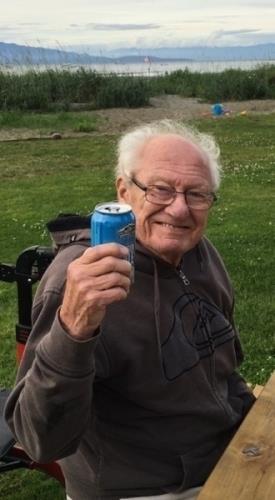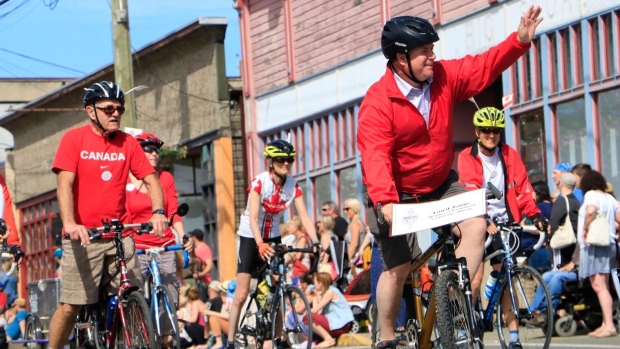The Cross Canada Cycle Tour Society September 2017, Volume 34, Issue #9
President’s Report John Pringle
“The final leg” and e-bikes – “To be or not to be.”
Last months of a presidency. Well folks, the Board is working under the agenda of the last leg of my Presidency. Hard to believe these past 20 or so months have gone so quickly. The Board has much work to do prior to the AGM (27th November) where the new Board will be “elected”. The period leading up to this meeting will see us progress on Chapters implementation (Ed Fudge), website completion (Max McClanahan), tours and h&s leadership incentives (Charlene Dorward and Bruce Daykin), and the appointment of a new Board member who will be tasked with the responsibility to develop a plan to improve the Club via the strategic use of banked monies. Please plan to attend this November meeting or ensure your representative has your ideas and suggestions on the meeting’s agenda topics.
E-bikes: Victoria CCCTS members have available to them the superbly led (Sharlane and Rolf) “Better-late-than-never-gang”. They attract about 12 and 20 summer and winter riders respectively on their Sunday day-rides. Rolf recently noted that three members now use e-bikes. Each has adopted their power-assisted bikes because of health problems. For those of you who are unaware, “Fundamentally an e-bike is just a regular bicycle with and electric motor to provide … assistance. You can pedal normally and just use the motor to assist on hills and in headwinds or to use the motor all the time to make riding easier. The experience is entirely different say from riding a gas scooter or motorbike. Here the electric assistance is entirely smooth and silent, and it complements rather than supplants human power.” (See ebikes.ca; a ‘Grin Technologies’ report. Why Grin? Read further.). They are legal in Canada, and in BC they are limited to <500 watts and to speeds under 32 km/h. In other countries legislation has been developed/adopted, and typically, e-bikes are restricted to deliver only about 200 to 250 watts of power making maximum speeds only 20 to 25 km/h. By comparison a typical bicyclist can comfortably sustain about 150 watts (1/5th of horsepower); a fit one can sustain 300 watts for about 10 minutes.
There are cycling clubs who’ve banned e-bikes. In putting this question to Rolf he both quickly and strongly claimed they have their place within CCCTS. He very much supports members adopting this technology as their health and strength wane, and thereby keeping them at the pack’s back, and rendering each hilly ride a torturous affair. This technology allows them to ride. It allows them to continue to enjoy the “gangs” comradery and fresh air as they’ve always done. All he asks is that the e-bike riders maintain the etiquette and “rules of the road” long adopted by his “gang”. And for goodness sake don’t lord it over those gasping at the crest of hills.
For those of you who’ve stopped riding, or ride on flat routes only because of strength loss, do look into the e-bike alternative. No doubt there are fine bike shops in your neighbourhood with experienced e-bike sales staff. In researching this article, I discussed e-bikes with personnel from two leading Victoria BC bicycle shops. Both agreed; most prospective buyers can, after providing some basic information, take a model for a spin. Interestingly, one shop had no 2017 models left (they sell Specialized and Giant). Not only are they out of product, but both manufacturers are as well. The good news is that 2018 models will be delivered next week. He urged CCCTS Club members to come in, pick a hilly course, and then “share the grin” following ride completion. “Hills. What hills?”
Welcome New Members
| Peter | Haggerty | Ottawa | ON |
| Robert | Flieger | Kamloops | BC |
| Mary Lou | Gorrie | Victoria | BC |
Upcoming Tours
Tour Trip Report
- McMenamins Portland Trip Report
- 2017 Ottawa Valley Trip Report
- BC Lakes and Mountains 2017
- National Capital Hub and Spoke 1
- National Capital Hub and Spoke 2
- Princeton Tour Report
In Memoriam
Dennis V. PARSONS (January 28, 1925 – August 18, 2017)
PARSONS, Dennis – Life is short, even if you live to 92. Dad was born in Pietermaritzburg, South Africa in 1925, the eldest of 4 children. He led an incredibly full life before leaving us on August 18th. He has left behind his 3 grown children, Ken, Anne and Vicky (Elliott), along with son-in-law David, and his grandsons Kody, Darren and Dawson, as well as his sister Patricia (Halls). Dad also leaves behind his ex-wife and dear friend, Irene, after a 60-year relationship.
Dad started his world travels in the early 1950’s when he left Pietermaritzburg. He travelled and worked throughout Europe before settling down in Victoria. When he was 55 years old he returned to South Africa for the first time to run in the Comrades Marathon, which he ran again the next year – an incredible feat. This was the beginning of numerous runs for charity as well as a Triathlon that he completed in his late 50’s. He started his travels again after he retired from the Dockyard (DREP), and he never stopped. His mode of transport for this leg of his life was a bicycle. He rode with his cycling pals across the country, and many, many spots in between and afar, including 11 trips to New Zealand. It brought him great joy.
If anyone asks the secret to long life, Dad’s secret was white bread with chunks of butter and cheese, hot and spicy foods, and a glass of scotch or beer to finish the evening. He never ate a vegetable.
Dad was one of a kind – he was determined, opinionated, and always positive and he had a great sense of humour, as well as a thirst for knowledge. He was passionate about political, international and local issues and let his voice be heard in articles he sent regularly to the papers. His life was never dull.
Our Dad did not wish to have a funeral or memorial of any sort, but to all of his friends, please know that you meant the world to him and, along with family, made his life an incredible journey.
We miss you so much already. Our lives will never be the same but have been so much better for having spent so many years together with you. Totsiens Dad.
Dennis joined the club in 1986 and took part in the Cross Canada Tour of that year. He participated and led many tours and hub and spokes and served as a director from 1988 to 2000. During this time he was the Island rep and served as vice-president and president of the club. I have fond memories of Dennis. Unfortunately a philosophical disagreement ended his membership. – editor-
Bike for Sale
New, 2017 CANNONDALE T2 Touring bike, 61 cm frame.
Price at dealership is $C 1840. Open to offers to $C 1440, save $400!
This is an excellent touring, and all-around bike, with all the mounts for front and rear panniers and water bottles installed, disk brakes, STI shifters for easy “hands on the bar” shifting, touring tires etc. For more information on the T2 detailed specifications, see the Cannondale Canada website:
Contact: Ron Kot rkot@shaw.ca
What Moves You?
CCCTS members have an opportunity to participate in a common-sense study that could help to justify public infrastructure spending toward their interests!
The issue? Canada is committing to spend 180 billion on infrastructure over the next 12 years, and at the same time there are increasing concerns on rising health care costs. Is there any hope that government will make smart investments and apply some of the infrastructure money in a way that will actually reduce health care costs? The answer is yes, through the idea that providing infrastructure which increases active transportation, such as bike lanes, the result is increased population health and lower health care costs.
Who and Where? Funded by the Canadian Institutes of Health Research, the Interventions, Research, and Action in Cities Team, (known as INTERACT) is evaluating the health impact of major changes in urban infrastructure, initially in Victoria, Vancouver, Saskatoon and Montreal. INTERACT is a new national collaboration of scientists, public health experts and urban planners. CCCTS members have an easy and interesting opportunity to participate in studies aimed at clarifying how changes in urban design, including bike infrastructure, impacts the health and wellbeing of Canadians.
Why and How? They need our help because they need more raw data. I participated in the study. You fill out an online questionnaire, wear a small sensing device (or download a mobile phone app) for 10 days and do your normal activities. That’s it. They are recruiting through September, for Victoria. Vancouver timing is to be announced.
What is not to like? They actually pay a small gratuity for participating and you get a printout of your activity. More importantly, you help the cause to have data and evidence as the basis for directing policy on where your tax dollars get spent. This “smart policy” approach, is a broader systems approach, aimed at proving connections between connected issues. The approach supports more effective use taxpayer dollars, thus saving you money, as well as increasing health and wellbeing. But your cycling use data is needed. Such a win win situation deserves your support. To learn more and to join the Victoria study, visit www.teaminteract.ca/victoria
Submitted by Ron Kot, Victoria CCCTS, after discussions with Meridith Sones, INTERACT team member.
Can cities make us healthier by design?
Hundreds of cyclists join new study on the health impact of Victoria’s bike network.
August 23, 2017
By Meridith Sones, Manager of Knowledge Mobilization, INTERACT
There is an old saying that the bicycle is a simple solution to some of the world’s most complicated problems. Getting around our cities by bike saves us time, money, and is good for the planet. But what about our health and wellbeing? Evidence shows that biking and other types of “human-powered” transportation can help to address the growing burden of physical inactivity, now the fourth leading cause of death globally. In Canada alone, the health care costs of physical inactivity are close to $7 billion annually. Public health experts say that to address this pandemic, we need to reimagine our cities and neighbourhoods into places that nudge us into moving more, and sitting less.
Victoria is one of several cities around the world investing in infrastructure to encourage more people of all ages and abilities to ride bikes due to the promise it holds for our health, our economy, and our environment. Victoria’s new All Ages and Abilities (AAA) Cycling Network will eventually add 24km of enhanced bike infrastructure across the city. While a city-wide protected cycling network has yet to be implemented anywhere in Canada, Victoria’s investment isn’t just about becoming a world-class cycling destination. Could reimagining Victoria into a more bike-friendly city make it a happier and healthier city to live, work, play, and age? This is the big question motivating all of us at INTERACT, and we’re inviting CCCTS members to help us find the answer.
INTERACT (INTErventions, Research, and Action in Cities Team) is a new national collaboration of leading scientists, public health experts, and urban planners uncovering how the design of our cities is shaping the health and wellbeing of Canadians. Launching in four cities across Canada – Victoria, Vancouver, Saskatoon, and Montreal – INTERACT will be evaluating the health impact of real world urban form interventions that represent an investment of more than $225M. We’re focused on three key outcomes linked to the design of our urban environments: physical activity, social participation and wellbeing.
Our first stop is Victoria, where hundreds of people have already joined our five-year study on the health impact of the city’s growing cycling network. If you ride a bike at least once a month in the City of Victoria, there’s still time to join the ride! Participants are invited to fill out two surveys and collect locational data through a mobile phone app or an accelerometer device. Data collection will take place this fall, and then be repeated twice more over the next five years. In each year of the study, you’ll receive a personalized report of your cycling activity and a small gift card as a token of appreciation for your time.
Getting enough physical activity likely isn’t a problem for the average CCCTS member, who already enjoys the health benefits–and the pure joy–that comes from the simple act of getting around by bike. The INTERACT study is a rare opportunity for CCCTS members to turn their love of cycling into data that will help us understand how cities can be happier and healthier by design.
Join the ride!
To learn more about INTERACT and join our study in Victoria, visit www.teaminteract.ca/victoria.
To get the latest on INTERACT’s research, including the launch of our future studies in Vancouver and other cities in Canada, email us at info@teaminteract.ca or follow us on Facebook at www.facebook.com/TeamInteract.ca/.
Funding for the Interventions, Research and Action in Cities Team (INTERACT) is provided by the Canadian Institutes of Health Research.
Vancouver Island MP pedals across riding in push for national cycling strategy
“We need to do better,” says Courtenay-Alberni MP Gord Johns of bike safety and infrastructure
By Megan Thomas, CBC News Posted: Aug 03, 2017 6:57 AM PT Last Updated: Aug 03, 2017 6:57 AM PT
Member of Parliament Gord Johns, seen here at an event in the Comox Valley, is about to log up to 60 kilometres a day biking around his Vancouver Island riding. (Candace Wu)
An NDP MP from Vancouver Island is hoping to pedal his way to better bike safety in his riding and across the country.
Courtenay-Alberni MP Gord Johns is preparing to ride across large swaths of his 8,500 square kilometre riding to bring attention to his push for a national cycling strategy.
Some parts of the riding are known for steep, twisty roadways that are far from bike-friendly — but Johns says that’s the point.
“We need to do better at creating more safe cycling opportunities, not just here in Courtenay-Alberni, but across Canada,” he said.
It’s not uncommon to see Gord Johns on a bike. He also commuted on two wheels through the winter in Ottawa.
During the 12-day bike tour of his riding later this month, Johns will log up to 60 kilometres a day and will visit more than 30 communities.
Some of the days will also be spent on water taxis to reach remote villages on the west coast of Vancouver Island.
The riding of Courtenay-Alberni strentches across central Vancouver Island. (Elections Canada)
Push for national safety standards
“There are areas of our riding where our cycling infrastructure is good, and some of it that it is very weak. So it’s something that we are going to be working with local communities on,” he said.
Johns hopes the ride will also draw attention to his push for a national cycling strategy.
He wants the federal government to commit to targets for expanding cycling infrastructure and improving safety standards.
Research shows other countries have been successful at getting more people out of cars and onto bikes through similar national plans, he said.
A national strategy in Canada could help the federal government play more of a role in funding and developing safe infrastructure, said Kay Teschke with the Cycling in Cities research program at UBC.
“The federal government can put out model standards,” she said. “They could provide matching funding in the same way we get matching funding for transit.”
Private members’ bills rarely become law, but promoting more cycling fits with some of the priorities of the federal Liberals, such as increasing transportation safety and decreasing carbon emissions, she added.
More federal funding could also help speed up cycling projects that local governments are already trying to tackle, said Richard Campbell, executive director of the British Columbia Cycling Coalition and board member for Canada Bikes.
“In B.C. we have added up what communities and regions have estimated they will need for their cycling networks and it comes to $2 billion,” he said.
Following the bike tour of his riding, Johns will return to Ottawa to try to convince fellow MPs to support his private member’s bill to create a national cycling strategy.
Newsbrief
Published at least ten times a year by The Cross Canada Cycle Tour Society, a non – profit organization for retired people and others who enjoy recreational cycling.
Items for the NEWSBRIEF must be received by the 28th of the month. The Editor reserves the right to edit for clarity, brevity and suitability of publication. The views expressed in the “NEWSBRIEF” are not necessarily those of the CCCTS or the Editor.
Submissions for NEWSBRIEF should be emailed to derailler@gmail.com
Please be sure to notify the office of any changes in your personal contact information; be it address, phone or e-mail.



